![]()
![]()
ARTSAKH IN THE FOREFRONT OF
THE NATIONAL LIBERATION MOVEMENT - PART III
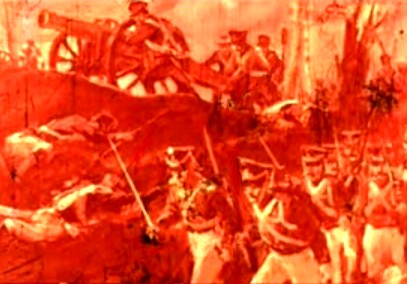
A R M E D S T R U G G L E A G A I N S T T Y R A N N Y
Written by Gevork Nazaryan
In the nineteenth century, Shushi, the center of Artsakh, became the third largest town in Transcaucasus where Armenian culture and education flourished. Shushi had a major impact on the development of culture of the entire Transcaucasus, including the Tatar (later "Azerbaijani") culture. The cultural and socio-economic boom of Shushi was suddenly cut short, when on March 23, 1920 the Turkish troops invaded Shushi and perpetrated a bloody massacre of the local Armenian population and burned Shushi to the ground. The Turkish government pursued the racist pan-Turkist policy of genocide. The Armenians of Shushi just like all Armenians that became the victims of the Armenian Genocide -- 1915 - 1923 -- by pan-Turkists in the East and the West fell as martyrs in the first genocide of the twentieth century. The horrific butchery in Shushi, the loot and the subsequent torching of Shushi ended the life of the prospering town. Stepanakert, was erected. This period was one of the most bloodiest eras in the history of these ancient people. It was during these years that Artsakh became the subject of "territorial disagreements."

THE OUTSTANDING ARMENIAN GENERAL COUNT LORIS-MELIKEAN.
THE COUNT DISTINGUISHED HIMSELF IN THE 1877-78 RUSSO-TURKISH WAR
FOR THE LIBERATION OF WESTERN ARMENIA FROM TURKISH OPPRESSION.
COUNT LORIS-MELIKEAN WAS A RARE BREED OF GENERALS GREATLY
BELOVED BY HIS SOLDIERS [AND GREATLY DISLIKED BY THE GENERAL
COMMAND FOR "RUBBING SHOULDERS WITH COMMONERS" AS ONE OF THE
REPORTS BY ANOTHER GENERAL TO THE TSAR REPORTED.
HE OFTEN PERSONALLY LED THE CAVALRY CHARGES AGAINST THE ENEMY.
HE WAS DISCHARGED BY TSAR IN 1881 FOR HIS ADVOCACY OF GRANTING MORE
RIGHTS TO ALL OF THE SUBJECTS OF THE RUSSIAN EMPIRE,
[HE WAS THE GOVERNOR OF TEREK IN DAGHESTAN, NORTHERN CAUCASUS]
MOST NOTABLY THE COMMON FOLK.

ALEXANDER V. SUVOROV [1729-1800]. THE OUTSTANDING GENERAL
OF THE
RUSSIAN EMPIRE KNOWN AS THE 'HERCULES' AND 'THE FIRST SWORD OF MARS'
[ROMAN GOD OF WAR] OF THE IMPERIAL ARMY WHO DISTINGUISHED
HIMSELF IN MANY CAMPAIGNS THROUGHOUT EUROPE AND ASIA. FROM HIS
MOTHER DŠXUHI MANUKIAN'S SIDE OF
ARMENIAN EXTRACTION
FROM A FAMILY OF WARRIORS. HIS GRANDFATHER SIMON WAS
DISTINGUISHED OFFICER IN THE ELITE BODYGUARD [LIEBGUARDE]
OF PETER THE GREAT. WHILE HIS SON THEODOSIOS
DISTINGUISHED HIMSELF IN THE SERVICE OF CATHERINE THE GREAT.

MEDAL IN HONOR OF THE LAZARIAN NOBILITY
In spring of 1918, after the conclusion of the Brest Agreement Turkey actively pushed its aggressive policy in Transcaucasus and due to its efforts, the Transcaucasus Seim declared about the independence of Transcaucasus from Russia. Shortly thereafter Turkey occupied the major part of Armenia, and only after the defeat at Sardarapat Battle was obliged to temporarily stop its advancement in the direction of Baku and the Caspian Sea. On May 26, 1918 the Transcaucasus Seim promulgated about self-dissolution and each of the national factions in the Seim declared about the reinstitution of their national statehood. Thus, three democratic republics were established in Transcaucasus. Unlike Armenia and Georgia, for the first time in the history the state of Azerbaijan appeared in the political map of Transcaucasus which did not exist previously. The name for the Moslem population of East Transcaucasus was taken from the terminology of the Iranian state which had the respective region with its center Tebriz. In the 16th-18th centuries the Persian vicegerents were responsible for the fiscal affairs of the entire Transcaucasus which was the subject of Iran (Persian Documents of the Matenadaran. Vol. II, Issue I. Compiled by A. D. Papazian, Yerevan, Publication of the Academy of Sciences of Arm SSR, 1968, pp. 345-348 ) . However, since during the period from May through July, 1918 the power was in the hands of the Baku Commune (headed by Stepan Shahumian), the Azerbaijani government based in Gandzak (Gianja) until the Turkish troops occupied Baku. As a matter of fact, the defense forces of Baku basically constituted Armenians. In September, 1918 the members of the Baku Commune were brutally executed. With the assistance of Great Britain, Turkey successfully strengthened its position in Baku and the establishment of the new Turkic Azerbaijani state was initiated. The Turks tried to expand the borders of the newly established state by massacre and ethnic cleansing of Armenian populated towns and villages.
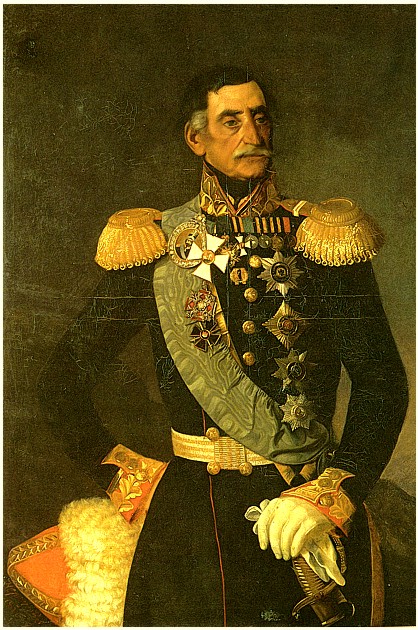
PORTRAIT OF GENERAL V. BEBUT‛EAN
WHO PLAYED A CRUCIAL ROLE IN THE
LIBERATION OF ARMENIA FROM FOREIGN YOKE. S. NERSISEAN [1857].
The Caucasus Tatars themselves were puzzled by the assignment of the name "Azerbaijan". In 1925 Academician V. V. Bartold was asked the following question at one of his classes in the University of Baku: "The name 'Azerbaijan' is widely regarded for the Persian province of Azerbaijan, with the center of Tabriz. In this respect, do we have the right to call this country 'Azerbaijan.' Or is it more appropriate to use the name Shirvan?"

HIGHLANDER ARMENIC FOLK COMMUNITY
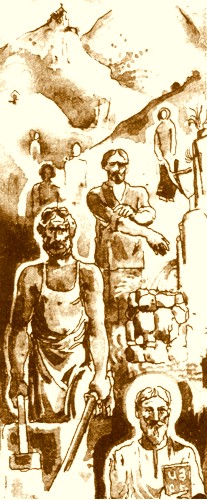
Academician Bartold gave the following answer: "Shirvan was never used in the sense that it encompassed the territory of the present Azerbaijani Republic. Shirvan covers a small area with the main town of Shemakha. Towns like Giunja and others, did not ever constitute part of Shirvan. The name Arran is the most appropriate term for all the regions incorporated in the Azerbaijani Republic. However, the name Azerbaijan is chosen because it was anticipated that the Persian Azerbaijan and this country would be merged into one state since the compositions of their populations are almost identical. Therefore, the name Azerbaijan was assigned to the republic…" (V. V. Bartold, "Collection of Works", Vol. II, Part I, Moscow, 1963, p. 703 ).

IN MANY VILLAGES AND TOWNS
THE ARMENIAN DEFENDERS FOUGHT IN ORDER TO SAVE
THOUSANDS OF WOMEN, CHILDREN AND ELDERS
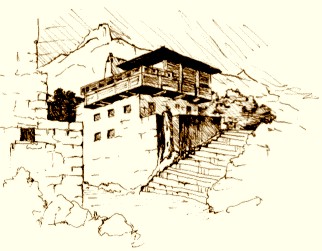
After the Turkic Musavatist party came to power, a hateful ideology and an agenda of Pan-Turkism was adopted from the Young Turks. This in of itself included a far-reaching dimension of implementation of the genocide towards the Armenian population of Nagorno Karabagh, Siwnik' [Zangezur] and Nakhichevan [Gołt‛an, often referred as KapArGoght -- united Armenian provinces of Kapan, Arevik‛ and Goghtn], thus ensuring direct connection -- without Armenians -- between Turkey and the newly promulgated "Azerbaijan." This horrific anti-Armenian policy led to the implementation of the Armenian Genocide in Eastern Armenia. Until 1921, Azerbaijan failed to hold possession of the Armenian territories, and only after the conclusion of the Treaty of Moscow, signed on March 16, 1921, Turkey achieved its goal of separating Nakhichevan from Armenia and the inclusion of the exclave [Nakhichevan, borders Armenia and has no common border with Azerbaijan] into the administrative system of newly established Azerbaijan.
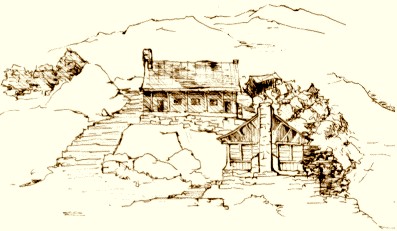
ARMENIAN CAUCASIAN RIDER -- HIS HORSE, HIS GUN AND HIS GIRL
ALWAYS RIDE TOGETHER. ALWAYS ON THE MOVE. ALWAYS IN FREE SPIRIT.
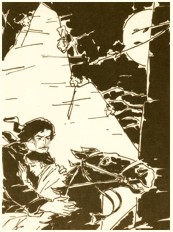
ARMENIAN FIGHTERS FOUGHT TO DEFEND THE FREEDOM,
HONOR AND LIFE OF ARMENIAN WOMEN AND CHILDREN
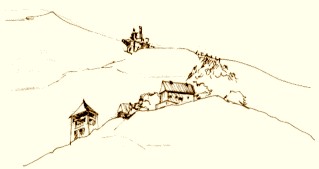
Under the Resolution of the Caucasus Bureau of the Central Committee of the Russian Communist [Bolshevik] Party [RCP(B)] of July 5, 1921 the same actions were taken with respect to Nagorno Karabagh. The resolution on the status of Karabagh was definitely taken as the result of the subjective judgments [the failed policy of appeasing "Red Turkey" and newly created Azerbaijan being one of the main reasons] and was devoid of any objective and clearly substantiated grounds. On June 3, 1921 the Caucasus Bureau of the RCP(B) promulgated the Resolution on the connection of Nagorno Karabagh with Armenia, and the resolution was approved on July 4, 1921. Nevertheless, the next day, on July 5 the resolution was revised and a decision was taken on passing Karabagh -- with a ninety percent plus Armenian majority -- to Azerbaijan along with granting broad autonomy and forming the administrative center of Shushi. Nevertheless, the leaders of Azerbaijan did not agree to assigning even administrative-territorial autonomy to Armenian Nagorno Karabagh. After two years' deferment, on July 4, 1923 the Presidium of the Central Operating Committee of Soviets of Azerbaijan has obliged under strong objection from the Armenian Karabagh and the pressure of the Caucasus Bureau to promulgate a resolution on the establishment of Nagorno Karabagh Autonomous Oblast. Thus, after Turkey took control over Transcaucasus (1918-1920), it succeeded in setting up a sound foundation for its far-reaching intentions of Pan-Turkism. Therefore, it is not surprising why that even to this day the Turkish military controlled government runs a firm anti-Armenian policy.
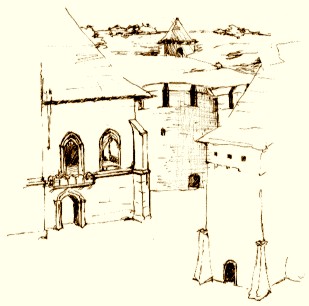
Turkey's policy was targeted at providing support to Azerbaijan in its attempts to subdue Artsakh, the very region of Armenia which was the symbol and warrant of independence and state autonomy of Armenia throughout the period from the Thirteenth to the Nineteenth century, especially after the fall of the Kingdom of Cilician Armenia in 1375.

HIS HOLINESS CATHOLICOS NERSES OF AŠTARAK.
ONE OF THE SPIRITUAL
LEADERS OF THE XIXTH CENTURY NATIONAL LIBERATION MOVEMENT.
The synopsis of the aforementioned facts and testimonies is given by V. Potto, one of the competent and objective investigators of the history of Karabagh: "Among the remnants of the previously prospering Armenian Kingdom of Karabagh which was under the suzerainty of Persia [South Caucasus was entirely under the control of Iran until its connection with Russia in 1813] only in one domain the patrimonial strongholds of the Armenian meliks were preserved. They covered the area from the Arax to Kurak-chai, about 20 versts from Gianja, the present Yelizavetpol [ancient Gandzak]. In Artsakh, or Lowland Karabagh these domains included Dizak, Varanda, Khachen, Charopert and Giulistan (Igirmi-Dort) which constituted the Karabagh dominion, as stated in the old Russian sources.
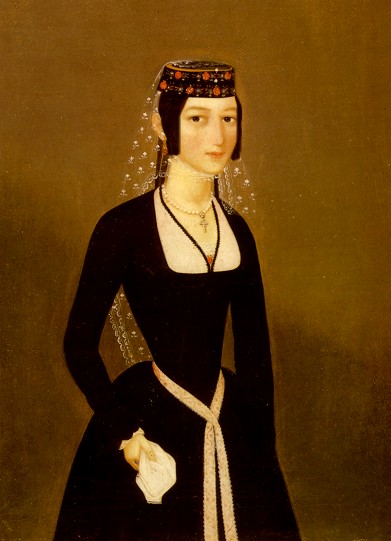
PORTRAIT OF NATALIE TEUMIAN [1830] BY H. HOVNANIAN.
There was only one major melikdom, Kashatagh, in the mountainous part of Karabagh, Siwnik' or Zangezur. It was surrounded with other smaller melikdoms, and the area stretching towards the River Arax was mainly inhabited by the Tatar nomads. In the view of the downfall and total destruction of the Armenian Kingdom, the rulers of these domains, i.e., the meliks, were able by their own efforts to maintain the right of succession and even to preserve until the beginning of the Nineteenth century the political system which was set
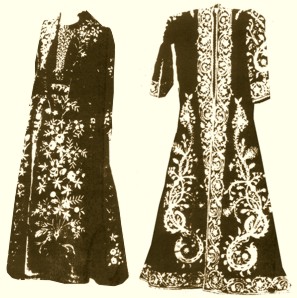
TRADITIONAL ARMENIAN LADY DRESSES WITH
SERPENTINE VISHAPS AND FERTILITY/VEGETATION/LIFE SYMBOLS.
up here since the time of Persian royal dynasty of Safavids. As the vassals of Persia, the meliks received their rights of succession by the Persian shahs and paid a tribute, for which they maintained their independence in the domestic administration of their lands, they had their courts and judicial system, their fortresses and even an army which protected the region from the Lezgins and Turks" -- V. Potto, "The first volunteers of Karabagh in the period of establishment of the Russian dominion.
![]()